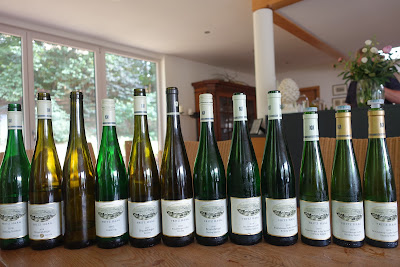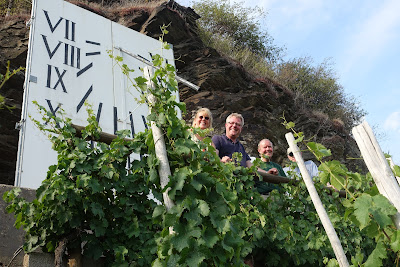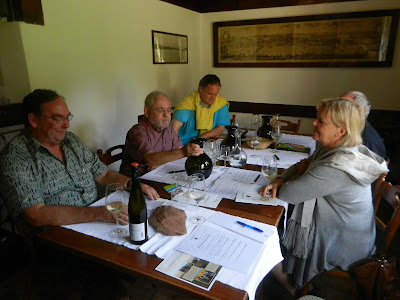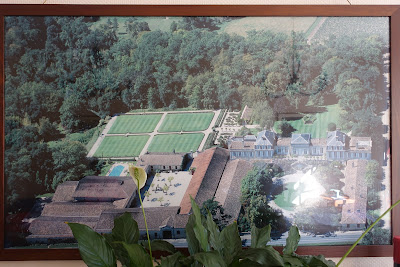Pictures: Tasting at Vins Jean-Luc Colombo in Cornas, Northern Rhône - Rhône Valley Tour 2018 by ombiasy WineTours: Wine, Culture and History, France
Vins Jean-Luc Colombo in Cornas, Northern Rhône, is a relatively young winery by French standards, established in 1987. Today Jean-Luc Colombo is one of the most progressive and influential winemaker of his generation and is nicknamed “The Winemaking Wizard of the Rhone.”
Jean-Luc, a native of Marseille, moved with his wife Anne to Cornas in 1982 to set up a pharmacy and oenology lab. Both are oenologists and they created the “Centre of Oenology of Côtes du Rhône” in Cornas in 1984. Jean-Luc has ever since been a consulting winemaker for some 100 of the best “Domaines” in the Rhône Valley, Provence and Bordeaux.
In 1993 Anne and Jean-Luc sold the pharmacy to focus only on wine. They purchased more vineyards and started to work as négociants in the region. The Domaine now has 30 acres of vineyard holdings in Cornas. The bulk of the entire production is through the négociant business, with around 30 wines, the biggest line being the Côte de Rhône.
I had met Jean-Luc Colombo in Washington DC, a few months before our visit and had established contact with Jean Luc. Jean Luc was not there when we visited the estate and the visit was a tasting only event.
Pictures: Christian Schiller and Jean-Luc Colombo at the French Embassy in Washington DC. See:
Jean-Luc Colombo, Cornas, Rhône Valley, Presented his Portfolio at the French Embassy in Washington DC, USA
Palm Bay International/ Jean-Luc Colombo
The wines of Jean-Luc Colombo are imported into the USA by Palm Bay International.
Palm Bay International: What happens when you combine a creative, adventurous spirit with an unbridled passion for wines of quality and character? For lovers of fine wines from France's Rhône Valley, the answer is simple: Jean-Luc Colombo.
"Jean-Luc Colombo has become one of the stars of Cornas. Well-known as an oenologist for dozens of Rhone Valley clients, Colombo has had a positive influence in the Rhone, undoubtedly improving the quality of many estate's wines. As for his own wines, there are usually three cuvees of Cornas. In ascending order of quality they are: Les Terres Brulees, Les Ruchets (from a specific vineyard), and La Louvee (formerly known as cuvee JLC) ." (Wine Advocate)
"One of the most influential figure in Rhone wine making in the last 20 years has been the Bordeaux-trained enologue Jean Luc Colombo, who advises many a grower on his wine making and has built up his own Estate at Cornas. Colombo's wines demonstrated what he preaches: they are impeccably vinified, richly fruity and heavily oaked wines without rough edges." (James Turnbull)
"Top 100 Wineries of the Year 2008" (Wine & Spirits Magazine)
"A Cornas wine comparable to the best grand crus" (Le Monde)
"Jean-Luc Colombo shakes up the Rhone Valley. A Cornas wine which is among the best wines." (Le Figaro)
"With his eloquence, his appetite for life, and his incredible ability to realize countless ideas, Jean-Luc Colombo is one of the most endearing characters of the French wineries" (Bettane et Dessauve)
Pictures: Tasting at Vins Jean-Luc Colombo in Cornas, Northern Rhône - Rhône Valley Tour 2018 by ombiasy WineTours: Wine, Culture and History, France
Wine Spectator/ Winemaker Talk: Jean-Luc Colombo
Posted: April 26, 2007
Wine Spectator: Winemaker Jean-Luc Colombo, 50, jokes that he's a bit of a Rhône outcast since he relies on modern techniques in one of France's most traditional wine regions. At the same time, it's hard to imagine where the Rhône would be without him, since Colombo was among the first to travel outside the area and not only aggressively market his own wines, but also tell the story of the entire region. Colombo grew up in a family of cooks, so he knew about food and wine early on, but at first he chose to be a pharmacist instead. It was a short-lived career move; he purchased his parcels of vines in the 247-acre Cornas region in 1986. From that humble start, he now makes his small-production, sought-after Cornas cuvées (Terres Brûlées, Les Ruchets and La Louvée), as well as a range of other wines, mostly from purchased grapes, reaching all the way down the valley to a $9 Côtes du Rhône.
Colombo has even begun to make wines from the Côte Bleue, near Marseilles, from old and neglected vines he found in a national park. The project is near to his heart since it brings him back closer to where he grew up. In addition, Colombo remains in high demand as a consultant, in and out of the Rhône Valley. But wherever he works, his focus remains squarely on making wines that work well with food. He took a quick break between tastings and consulting appointments to talk about his inspirations and his own influence on Rhône winemaking.
Wine Spectator: How did you first get interested in winemaking?
Jean-Luc Colombo: I was first interested in the taste of wine. My mother was a chef--I grew up in a kitchen environment, with a grandmother and a mother who were great promoters of the culinary tradition of Marseille. Not all winemakers have a passion for food, but because everyone in the family was a chef, all we talked about was food. Then, I really discovered enology during my pharmaceutical studies. I got a pharmacy license, and decided to open a lab. The lab was [similar] to winemaking.
WS: What makes Cornas so different from the rest of the Rhône Valley?
JLC: Cornas is part of the Northern Rhône hillsides, which is where Syrah comes from, and where Syrah gives its greatest expression. At the same time, the hills of Cornas benefit from Mediterranean influences, which bring a lot of character to the wine.
WS: And your wines from Côte Bleue?
JLC: That's very different from Cornas. Cornas is the best landscape and soils for Syrah--it's very porous. So we can have a good Syrah with a lot of aromas of flowers like lilac and iris. With the fruit it's black currant or licorice. But the Côte Bleue is more for Mourvèdre and Syrah because the land is chalk. It's also a peninsula--almost like an island. You have the huge Lake of Berre, maybe a 30-mile circle, and then south is the sea. It's almost like Long Island. When you're there it's always cool. Not cold, not hot. So the Côte Bleue is a very good terroir to grow Syrah and Mourvèdre. The taste of the grape is never too mature--it's always 13.5 percent alcohol. We never get 15 percent. There is no residual sugar, and we don't use irrigation, because we have the humidity on the leaves.
WS: You've joked sometimes that you're the most hated and loved winemaker in the Rhône. Why?
JLC: Well, when I arrived in the Northern Rhône, techniques were very old-fashioned, and I shook some habits (I use new oak, destemming, green harvest). Obviously, this did not please a few narrow-minded winemakers. Conversely, I did get credit because I contributed to improving today's wine quality and also because I myself invested a great deal to promote the wines of the area.
WS: Who have been some of your greatest influences?
JLC: When I discovered enology I read Le Gout du Vin, by the great Bordeaux enologist Emile Peynaud. In the early years of my career, I also got to meet Michel Rolland, who showed me the importance of the role of the consultant, when most enologists were only interested in analysis.
WS: What would you say is the main difference between someone like you and Rolland?
JLC: We share common ideas, but we have always worked in different wine regions, either different by size or notoriety. I'm very close to the thinking of Michel Rolland--I work like him, he works like me--and we are very close. He's a good friend.
But maybe the difference is I think more about the food [that goes with the wine]. The food 40 years ago and 20 years ago and five years ago is different. But the wine [has always been] the same. I love the fruit of the grape. When you eat the grape in September, the taste is of blueberry, blackberry and strawberry, and I like to find the taste of the grape in the wine, in the glass. I try to have the fruit in the bottle, in that glass of wine.
WS: How do you get that?
JLC: We need to be very clean. Clean cellar, clean barrel. You need to wash your hands, wash the baskets. Simple, but in fact, it's very difficult to be clean.
WS: What are some of your favorite things to cook and eat with your wines?
JLC: Very simple things. Like a truffle with a T-bone and marrow. Maybe not in summer … but very good in winter or autumn. Cornas is also much better with venison. And of course, Lièvre à la Royale, which is stuffed and braised rabbit. There is a very famous recipe--it's cooked for a long, long, long time, maybe 18 hours. The stuffing is truffle, foie gras, a lot of spice and good fleur de sel. Usually the hare is like a big sausage. You cut the hare in slices. It's the best! In the U.S. it's very difficult to find, but one chef who cooks it very well is Didier Virot at Aix. It's wonderful. It's a food to dream, because it takes so long to make.
WS: What is your favorite non-European wine?
JLC: Ridge, by winemaker Paul Draper. Usually you have to like the wine and drink it and you get pleasure, and that's it. The winemaking is good when you get pleasure in the glass. But when you know the guy--and we enjoy sharing food and wine with him--or the philosophy of the person, it is much better. I like him very much because he's very knowledgeable and he knows food and wine.
The Wines we Tasted
We tasted 7 wines, including 4 of Jean Luc Colombo's high-end wines.
2016 Jean-Luc Colombo, Côtes du Rhône Blanc, Les Abeilles
80% Clairette, 20% Roussanne, winer-searcher average price in US$: 13
2017 Jean-Luc Colombo, Saint Péray, La Belle de Mai
60% Roussanne, 40% Marsanne, winer-searcher average price in US$: 20
2016 Jean-Luc Colombo, Côtes du Rhône Rouge, Les Abeilles
60% Grenache, 30% Syrah, 10% Mouvedre, winer-searcher average price in US$: 14
2016 Jean-Luc Colombo, Cornas, Terres Brûlées
100% Syrah, winer-searcher average price in US$: 40
2013 Jean-Luc Colombo, Cornas, Les Ruchets
2010 Jean-Luc Colombo, Cornas, Les Ruchets
2006 Jean-Luc Colombo, Cornas, Les Ruchets
100% Syrah, Jean-Luc Colombo's signature wine, winer-searcher average price in US$: 79
2012 Jean-Luc Colombo, Cornas, La Louvée
100% Syrah, aged 22 months in new and used oak,winer-searcher average price in US$: 87
Rhône Valley Tour 2018 by ombiasy WineTours: Wine, Culture and History, France (Already Released and Forthcoming Postings)
Rhône Valley Tour 2018 by ombiasy WineTours: Wine, Culture and History, France
Rhône Valley Tour December 2017: From Lyon to Avignon - Wine, Food, Culture, History
Understanding the Wines of the Rhône Valley: The Classification - AOC/ Vin de Pay/ Vin de France
The Rhône Wine Region in Southern France and its Wines: History, Classification, Northern and Southern Rhône
Cellar Tasting, including from Barrel, at Domaine Éric Texier in Charney, with Laurence Texier - Rhône Valley Tour 2018 by ombiasy WineTours: Wine, Culture and History, France
Dinner at Le Bouchon des Filles in Lyon - Rhône Valley Tour 2018 by ombiasy WineTours: Wine, Culture and History, France
Dinner at a Bouchon - Chez Paul - in Lyon: Schiller’s Favorite Bouchons in Lyon, France
Cellar Tour, Tasting and Vineyard Drive at E. Guigal in Ampuis, Côte Rôtie, Northern Rhône - Rhône Valley Tour 2018 by ombiasy WineTours: Wine, Culture and History, France
Tasting at Maison Clusel-Roche in Ampuis, Côte Rôtie, Northern Rhône - Rhône Valley Tour 2018 by ombiasy WineTours: Wine, Culture and History, France
Tasting at Domaine Georges Vernay in Condrieu, Northern Rhône, with Owner Paul Ansellem-Vernay - Rhône Valley Tour 2018 by ombiasy WineTours: Wine, Culture and History, France
Dinner at Hôtellerie Beau Rivage in Condrieu, with Chef Chef Ludovic Mounier - Rhône Valley Tour 2018 by ombiasy WineTours: Wine, Culture and History, France
Cellar Tour and Tasting at Maison Delas-Frères in Saint Jean de Muzols, Saint Joseph, Northern Rhône - Rhône Valley Tour 2018 by ombiasy WineTours: Wine, Culture and History, France
Lunch at Restaurant La Grappe d’Or in Saint-Péray, with Chef Pierre Yves Jacques Sébastien - Rhône Valley Tour 2018 by ombiasy WineTours: Wine, Culture and History, France
Tasting at Domaine Jean Luc Colombo in Cornas, Northern Rhône
Vineyard Walk and Tasting at Paul Jaboulet Aîné in Tain-l’Hermitage, Hermitage, Northern Rhône
Cellar Tasting at Domaine Laurent Habrard in Gervans, Crozes-Hermitage, Northern Rhône, with Owner/ and Winemaker Laurent Habrad
Cellar Tour and Tasting at Domaine Combier in Pont de l’Isère, Crozes-Hermitage, Northern Rhône, with Owner/ Winemaker Laurent Combier
Lunch at La Grand Table de Michel Chabran, 1 Star Michelin, in Pont d l’Isère
Vineyard Tour, Cellar Tour and Tasting at Domaine Les Bruyères in Beaumont-Monteux, Northern Rhône, with Owner/ Winemaker David Reynaud
Winemaker Dinner with David Reynaud, Domaine les Bruyeres, Crozes-Hermitage in the Rhone Valley, at Chef Bart Vandaele's BToo in Washington DC, USA/ France
Cellar Tour and Tasting at Domaine La Martinelle in Lafare, Ventoux, Southern Rhône, with Owner/ Winemaker Corinna Kruse Faravel
Lunch at Restaurant Le Mesclun in Séguret, Southern Rhône
Cellar Tour and Tasting, including from Barrel, at Domaine Marcel Richaud in Cairanne, Southern Rhône, with Owner/ Winemaker Claire Richaud
Tasting at Domaine de Cabasse, Séguret, Southern Rhône, with Owner/ Winemaker Benoit Baudry
Wine Dinner at Restaurant Hôtel Domaine de Cabasse, Séguret, Southern Rhône
Lunch at Restaurant Le Dolium in Beaumes-de Venise, Southern Rhône
Vineyard Tour, Cellar Tour and Tasting of Wine and Olive Oil at Mas Saint Berthe, Les Baux de Provence, Southern Rhône, with Winemaker Christian Nief
Dinner at Restaurant Benvengudo, Les Baux de Provence, Southern Rhône
Cellar Tour and Tasting at Domaine du Pegau in Châteauneuf du Pape, with Owner/ Winemaker Laurence Féraud and Cellar Master Andreas Lenzenwöger
At Pont du Gard: Lunch at Restaurant Les Terrasses
Cellar Tour and Tasting at Domaine de la Mordorée, Tavel, Southern Rhône, with Owner Ambre Delorme
Cellar tour and tasting at Domaine La Bastide Saint Dominique in Courthézon, Châteauneuf du Pape, with Owner Véronique Bonnet and Owner/ Winemaker Eric Bonnet
Tasting at the Caveau of the Perrin Family in Châteauneuf du Pape
Cellar Tour and Tasting at Château la Nerthe, Châteauneuf du Pape
Wine-pairing dinner at Restaurant Château des Fines Roches, with Chef Hugo Loridan-Fombonnet
New Year’s Eve at Château des Fines Roches in Châteauneuf-du-Pape, France


 Pictures: In the Vineyards with Caroline Diel and Anouk. See:Tasting with Sylvain Taurisson Diel at Schlossgut Diel, Nahe – Germany-North Tour by ombiasy WineTours (2014)
Pictures: In the Vineyards with Caroline Diel and Anouk. See:Tasting with Sylvain Taurisson Diel at Schlossgut Diel, Nahe – Germany-North Tour by ombiasy WineTours (2014) 
































































